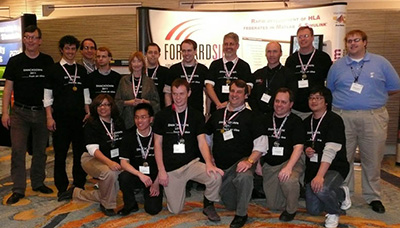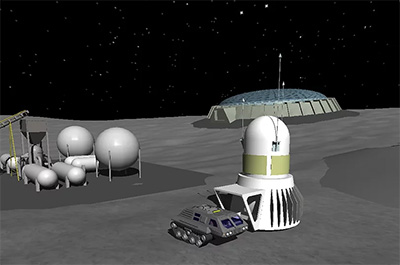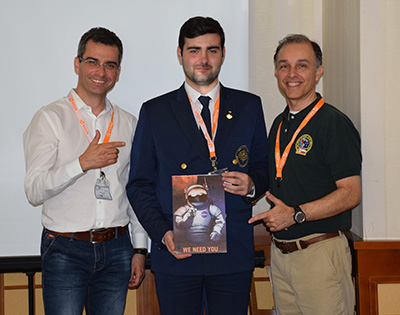Start a SEE Team today!
PAST EVENTS
SEE 2011
SEE, formally known as SISO Smackdown, was first hosted by SISO at the 2011 Spring Simulation Multi-Conference in Boston, Massachusetts, USA. Teams participating in SEE 2011 were:
- University of Bordeaux (France)
- University of Calabria (Italy)
- University of Genoa (Italy)
- Keio University (Japan)
- Massachusetts Institute of Technology (USA)
- North Carolina State University (USA)
- Pennsylvania State University (USA)
- Technion Institute (Israel)
Unfortunately, Keio University’s team had to withdraw after a massive earthquake and tsunami hit Japan shortly before the SEE event. Rather than participate directly, Technion Institute (Israel) did a study on scenario development and HLA visualization. The simulation scenario took place on the near side of the moon. Student teams’ simulations included a mining operation (MIT), cargo rover (MIT) driving to the supply depot (Genoa and Bordeaux), and meeting the Shuttle Lander (Penn State) which then launched from the lunar surface. MIT also provided the ISRU (In Site Resource Utilization) and the Hopper.
SEE 2012
SEE 2012 (also known as SISO Smackdown) took place in Orlando, Florida, USA. Teams participating in SEE 2012 were:
- University of Alabama / Huntsville (USA)
- University of Genoa (Italy)
- Massachusetts Institute of Technology (USA)
- Pennsylvania State University (USA)
SEE 2012’s scenario was the same as the previous year. MIT operated its ISRU (In Site Resource Utilization) and the Hopper. Penn State operated its Cargo Rover and Shuttle Lander. Genoa operated the Supply Depot and while working with MBDA added the Asteroid Protection System. Lastly, the University of Alabama Huntsville operated a new element in the scenario with the Satellite System and Mass Driver.

SEE 2013
In 2013 the conference name was officially changed to the Simulation Exploration Experience (SEE), which had been previously known as Smackdown. SEE 2013 was held in San Diego, California, USA. Teams participating in SEE 2013 were:
- University of Alabama / Huntsville (USA)
- University of Bordeaux (France)
- Brunel University (UK)
- University of Genoa (Italy)
- Massachusetts Institute of Technology (USA)
- University of Munich (Germany)
- University of Nebraska (USA)
- Pennsylvania State University (USA)

SEE 2014
SEE 2014 was held in Tampa, Florida, USA during the SCS Spring Simulation Multi-Conference. Teams participating in SEE 2014 were:
- University of Alabama / Huntsville (USA)
- University of Bordeaux (France)
- Brunel University (UK)
- University of Calabria (Italy)
- California Polytechnic (USA)
- University of Genoa (Italy)
- University of Munich (Germany)
- University of Nebraska (USA)
- Pennsylvania State University (USA)
17 distributed simulation federates added considerable complexity and record interactivity. The scenario started at the L2 outpost 3.3 miles above the Moon, where a Cargo Drone had just delivered supplies. The scenario progressed with transportation of an asteroid for mining (Penn State). The Communications Satellite (UAH) directed the Cargo Rover (Nebraska) to meet the Shuttle Lander (Penn State) for delivery of supplies to the Supply Depot (Genoa, Bordeaux). Also included was an Astronaut Health Monitoring System (Genoa), but technical difficulties prevented the astronaut (Brunel) from appearing within the simulation. Cal Poly also had similar difficulties while attempting to participate in the scenario with its simulated Space Elevator. UAH and Calabria worked together to warn those on the surface of the Moon of impending danger with the Asteroid Warning System, which in turn triggered an evacuation from the Moon’s surface while the Asteroid Protection (Calabria) tracked and destroyed an asteroid. When Calabria announced “All Clear”, the Mass Driver (UAH) assumed normal operations and launched a cargo drone to L2 Outpost (Munich).

SEE 2015
SEE 2015 happened in Alexandria, Virginia, USA. Participant teams included. Teams participating in SEE 2015 were:
- University of Alberta (Canada)
- University of Bordeaux (France)
- University of Calabria (Italy)
- California Polytechnic (USA)
- Faculdade de Engenharia de Sococaba / FACENS (Brazil)
- Florida Institute of Technology (USA)
- University of Genoa {2 teams} (Italy)
- University of Liverpool (UK)
- Midwestern State University (USA)
- University of Nebraska (USA)
- North Carolina State University (USA)
- Pennsylvania State Universite (USA)
- Stevens Institute of Technology (USA)

SEE 2016
SEE 2016 occurred in Liverpool, England, United Kingdom, coincident with the 2016 Society for Computer Simulation’s Spring Simulation Multi-Conference. Teams participating in SEE 2016 were:
- University of Alberta (Canada)
- University of Bordeaux (France)
- University of Calabria (Italy)
- California Polytechnic (USA)
- Faculdade de Engeharia de Sorocaba / FACENS (Brazil)
- Florida Institute of Technology (USA)
- University of Genoa (Italy)
- University of Liverpool (UK)
- Midwestern State University (USA)
- University of Nebraska (USA
- North Caroline State University (USA)
- Pennsylvania State University (USA)
- Stevens Institute of Technology (USA)

SEE 2017
SEE 2017 was held at the world’s most famous space launch location, Kennedy Space Center at Cape Canaveral, Florida, USA. Teams participating in SEE 2017 were:
- University of Alberta (Canada)
- University of Bordeaux (France)
- University of Calabria (Italy)
- California Polytechnic (USA)
- University of Central Florida (USA)
- Embry Riddle Aeronautical University (USA)
- Faculdade de Engenharia de Sorocaba / FACENS (Brazil)
- Florida Institute of Technology (USA)
- University of Genor (Italy)
- Midwestern State University (USA)
- University of Munich (Germany)
- Orange Technical College (USA)
- University of Sofia (Bulgaria)
The simulation scenario occurred on the Moon.

SEE 2018
SEE 2018 took place in Sofia, Bulgaria. Teams participating in SEE 2018 were:
- University of Bordeaux (France)
- Brunel University (UK)
- University of Calabria (Italy)
- University of Central Florida (USA)
- Faculdade de Engenharia de Sorocaba / FACENS (Brazil)
- Florida Institute of Technologyy (USA)
- Florida Space Institute (USA)
- University of Genoa (Italy)
- University of Gujrat (Pakistan)
- IMT Mines Alès (France)
- Naval Academy (Bulgaria)
- National Military University (Bulgaria)
- University of Munich (Germany)
- SMASH Lab (Italy)
- University of Sofia (Bulgaria)
The simulation scenario occurred on the Moon.

SEE 2019
SEE 2019 occurred at the Florida Institute of Technology in Melbourne, Florida, USA. Teams participating in SEE 2019 were:
- University of Calabria (Italy)
- University of Central Florida (USA)
- Dobrich High School (Bulgaria)
- Embry Riddle Aeronautical University (USA)
- Faculdade de Engenharia de Sorocaba / FACENS (Brazil)
- Florida Space Institute (USA)
- Florida Space institute (USA)
- University of Genoa (Italy)
- University of Gujrat (Pakistan)
- IMT Mines Alès (France)
- University of Munich (Germany)
- Naval Academy (Bulgaria)
- SMASH Lab (Italy)

SEE 2020
Teams participating in SEE 2020 were:
- University of Bordeaux (France)
- University of Calabria (Italy)
- University of Central Florida (USA)
- Dobrich High School (Bulgaria)
- Embry Riddle Aeronautical University (USA)
- Faculdade de Engenharia de Sococabe / FACENS (Brazil)
- Florida Space institute (USA)
- University of Genoa (Italy)
- University of Gujrat (Pakistan)
- IMT Mines Alès (France)
- University of Munich (Germany)
- Naval Academy (Bulgaria)
- SMASH Lab (Italy)

SEE 2021
SEE 2021 was held virtually only, due to the Covid pandemic’s restrictions on travel. Teams participating in SEE 2021 were:
- University of Central Florida (USA)
- Dobrich High School (Bulgaria)
- Faculdade de Engenharia de Sorocaba / FACENS (Brazil)
- Florida Space Institute (USA)
- University of Genoa (Italy)
- IMT Mines Alès (Frances)
- Naval Academy (Bulgaria)
- Sofia University (Bulgaria)

SEE 2022
SEE 2022 was held virtually only, due to the Covid -related travel restrictions were still in place. Teams participating in SEE 2022 were:
- University of Central Florida (USA)
- Dobrich High School (Bulgaria)
- Faculdade de Engenharia de Sorocaba / FACENS (Brazil)
- Florida Space Institute (USA)
- University of Genoa (Italy)
- IMT Mines Alès (Frances)
- Naval Academy (Bulgaria)
- Sofia University (Bulgaria)

SEE 2023
SEE 2023 was held in May 2023. The epoch selected for simulation this year is the time period between the initial establishment of a sustained human presence on the Moon and before humans go to Mars. This time period will include lunar surface habitation/exploration, Mars surface exploration, and the lunar orbital environment. As a result, participants in SEE 2023 have a wide range of simulation-based opportunity areas to consider and develop:
- Surface and sub-surface exploration, transportation, prospecting, harvesting, and mining systems for the Moon or Mars.
- Habitation and support infrastructure (power, cooling, heat, water, food, transportation, distribution systems) for the Lunar Village as well as more basic systems for remote outposts.
- Industrial infrastructure producing propellants, fuels, raw materials, construction materials, recycling and manufacturing capabilities.
- Transport and sale of products and services on base as well as through the Gateway station.
- Robotic outposts in remote lunar areas as well as on Mars, for exploration, prospecting, and in situ resource utilization (ISRU).








